Strategic Asia: Environmental Challenges, BRI, and Geopolitics
VerifiedAdded on 2020/03/07
|11
|3136
|59
Essay
AI Summary
This essay, focusing on Strategic Asia, delves into the significant environmental challenges confronting the region, including deforestation, land degradation, water management issues, climate change impacts, and air pollution. It examines the detrimental effects of these issues on food security, regional stability, and sustainable growth, emphasizing the need for proactive policy interventions. Furthermore, the essay explores the opportunities available to Asia in addressing these challenges, highlighting improvements in environmental governance and the adoption of holistic approaches. The second part of the essay analyzes China's Belt and Road Initiative (BRI), examining its economic and geopolitical implications, including potential impacts on bilateral rivalries and regional flashpoints. The essay discusses the BRI's objectives, challenges, and potential impact on the region. References from various scholars are used to support arguments and analysis.
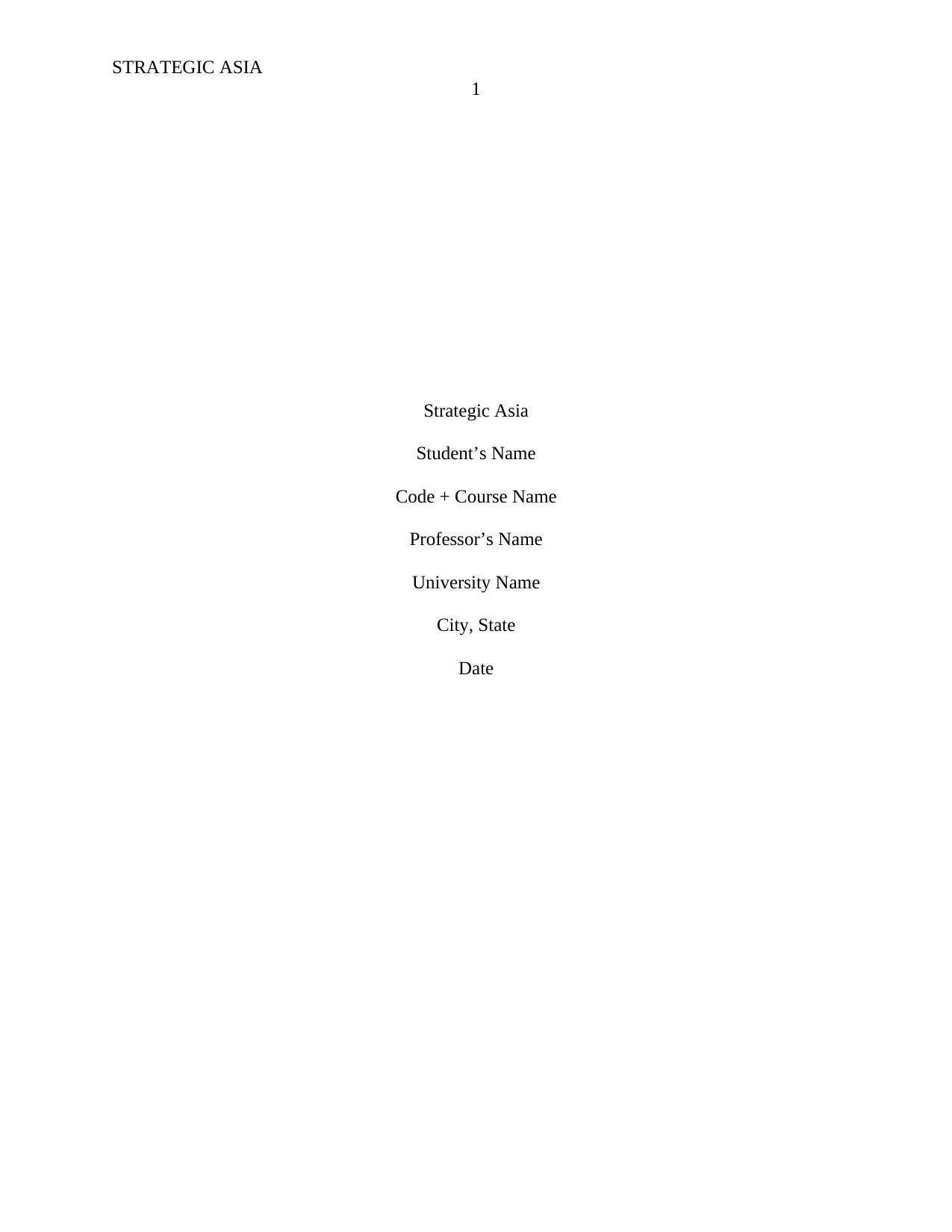
STRATEGIC ASIA
1
Strategic Asia
Student’s Name
Code + Course Name
Professor’s Name
University Name
City, State
Date
1
Strategic Asia
Student’s Name
Code + Course Name
Professor’s Name
University Name
City, State
Date
Paraphrase This Document
Need a fresh take? Get an instant paraphrase of this document with our AI Paraphraser
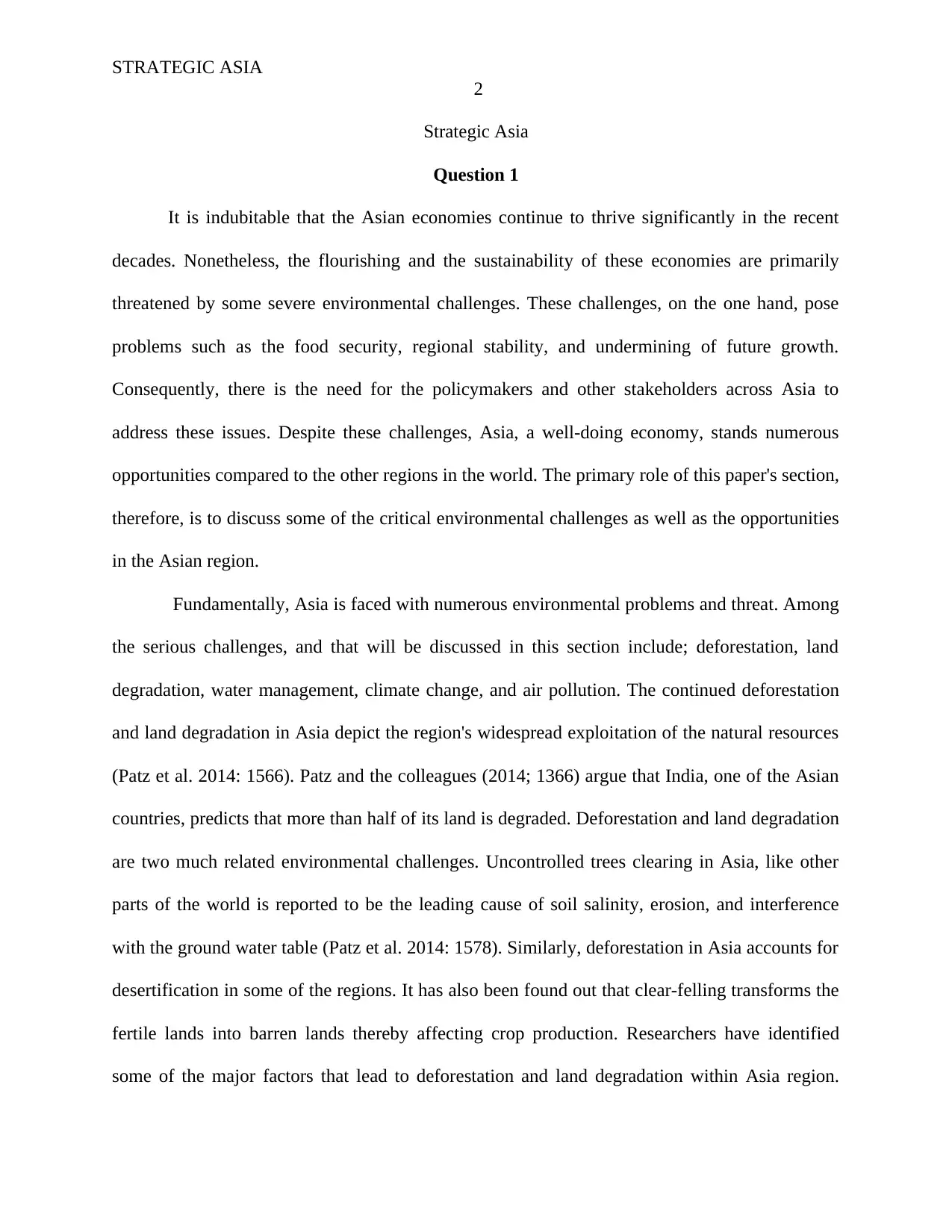
STRATEGIC ASIA
2
Strategic Asia
Question 1
It is indubitable that the Asian economies continue to thrive significantly in the recent
decades. Nonetheless, the flourishing and the sustainability of these economies are primarily
threatened by some severe environmental challenges. These challenges, on the one hand, pose
problems such as the food security, regional stability, and undermining of future growth.
Consequently, there is the need for the policymakers and other stakeholders across Asia to
address these issues. Despite these challenges, Asia, a well-doing economy, stands numerous
opportunities compared to the other regions in the world. The primary role of this paper's section,
therefore, is to discuss some of the critical environmental challenges as well as the opportunities
in the Asian region.
Fundamentally, Asia is faced with numerous environmental problems and threat. Among
the serious challenges, and that will be discussed in this section include; deforestation, land
degradation, water management, climate change, and air pollution. The continued deforestation
and land degradation in Asia depict the region's widespread exploitation of the natural resources
(Patz et al. 2014: 1566). Patz and the colleagues (2014; 1366) argue that India, one of the Asian
countries, predicts that more than half of its land is degraded. Deforestation and land degradation
are two much related environmental challenges. Uncontrolled trees clearing in Asia, like other
parts of the world is reported to be the leading cause of soil salinity, erosion, and interference
with the ground water table (Patz et al. 2014: 1578). Similarly, deforestation in Asia accounts for
desertification in some of the regions. It has also been found out that clear-felling transforms the
fertile lands into barren lands thereby affecting crop production. Researchers have identified
some of the major factors that lead to deforestation and land degradation within Asia region.
2
Strategic Asia
Question 1
It is indubitable that the Asian economies continue to thrive significantly in the recent
decades. Nonetheless, the flourishing and the sustainability of these economies are primarily
threatened by some severe environmental challenges. These challenges, on the one hand, pose
problems such as the food security, regional stability, and undermining of future growth.
Consequently, there is the need for the policymakers and other stakeholders across Asia to
address these issues. Despite these challenges, Asia, a well-doing economy, stands numerous
opportunities compared to the other regions in the world. The primary role of this paper's section,
therefore, is to discuss some of the critical environmental challenges as well as the opportunities
in the Asian region.
Fundamentally, Asia is faced with numerous environmental problems and threat. Among
the serious challenges, and that will be discussed in this section include; deforestation, land
degradation, water management, climate change, and air pollution. The continued deforestation
and land degradation in Asia depict the region's widespread exploitation of the natural resources
(Patz et al. 2014: 1566). Patz and the colleagues (2014; 1366) argue that India, one of the Asian
countries, predicts that more than half of its land is degraded. Deforestation and land degradation
are two much related environmental challenges. Uncontrolled trees clearing in Asia, like other
parts of the world is reported to be the leading cause of soil salinity, erosion, and interference
with the ground water table (Patz et al. 2014: 1578). Similarly, deforestation in Asia accounts for
desertification in some of the regions. It has also been found out that clear-felling transforms the
fertile lands into barren lands thereby affecting crop production. Researchers have identified
some of the major factors that lead to deforestation and land degradation within Asia region.
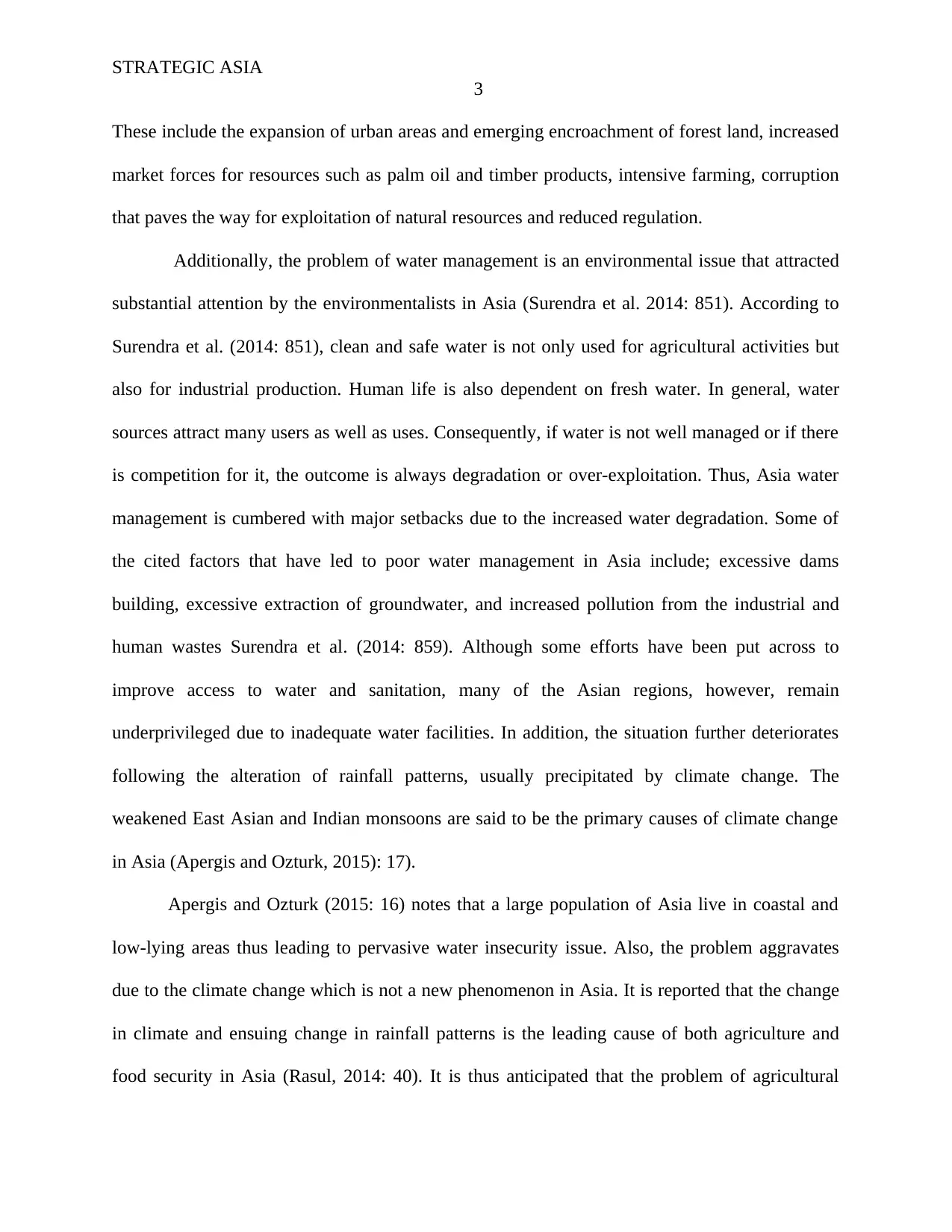
STRATEGIC ASIA
3
These include the expansion of urban areas and emerging encroachment of forest land, increased
market forces for resources such as palm oil and timber products, intensive farming, corruption
that paves the way for exploitation of natural resources and reduced regulation.
Additionally, the problem of water management is an environmental issue that attracted
substantial attention by the environmentalists in Asia (Surendra et al. 2014: 851). According to
Surendra et al. (2014: 851), clean and safe water is not only used for agricultural activities but
also for industrial production. Human life is also dependent on fresh water. In general, water
sources attract many users as well as uses. Consequently, if water is not well managed or if there
is competition for it, the outcome is always degradation or over-exploitation. Thus, Asia water
management is cumbered with major setbacks due to the increased water degradation. Some of
the cited factors that have led to poor water management in Asia include; excessive dams
building, excessive extraction of groundwater, and increased pollution from the industrial and
human wastes Surendra et al. (2014: 859). Although some efforts have been put across to
improve access to water and sanitation, many of the Asian regions, however, remain
underprivileged due to inadequate water facilities. In addition, the situation further deteriorates
following the alteration of rainfall patterns, usually precipitated by climate change. The
weakened East Asian and Indian monsoons are said to be the primary causes of climate change
in Asia (Apergis and Ozturk, 2015): 17).
Apergis and Ozturk (2015: 16) notes that a large population of Asia live in coastal and
low-lying areas thus leading to pervasive water insecurity issue. Also, the problem aggravates
due to the climate change which is not a new phenomenon in Asia. It is reported that the change
in climate and ensuing change in rainfall patterns is the leading cause of both agriculture and
food security in Asia (Rasul, 2014: 40). It is thus anticipated that the problem of agricultural
3
These include the expansion of urban areas and emerging encroachment of forest land, increased
market forces for resources such as palm oil and timber products, intensive farming, corruption
that paves the way for exploitation of natural resources and reduced regulation.
Additionally, the problem of water management is an environmental issue that attracted
substantial attention by the environmentalists in Asia (Surendra et al. 2014: 851). According to
Surendra et al. (2014: 851), clean and safe water is not only used for agricultural activities but
also for industrial production. Human life is also dependent on fresh water. In general, water
sources attract many users as well as uses. Consequently, if water is not well managed or if there
is competition for it, the outcome is always degradation or over-exploitation. Thus, Asia water
management is cumbered with major setbacks due to the increased water degradation. Some of
the cited factors that have led to poor water management in Asia include; excessive dams
building, excessive extraction of groundwater, and increased pollution from the industrial and
human wastes Surendra et al. (2014: 859). Although some efforts have been put across to
improve access to water and sanitation, many of the Asian regions, however, remain
underprivileged due to inadequate water facilities. In addition, the situation further deteriorates
following the alteration of rainfall patterns, usually precipitated by climate change. The
weakened East Asian and Indian monsoons are said to be the primary causes of climate change
in Asia (Apergis and Ozturk, 2015): 17).
Apergis and Ozturk (2015: 16) notes that a large population of Asia live in coastal and
low-lying areas thus leading to pervasive water insecurity issue. Also, the problem aggravates
due to the climate change which is not a new phenomenon in Asia. It is reported that the change
in climate and ensuing change in rainfall patterns is the leading cause of both agriculture and
food security in Asia (Rasul, 2014: 40). It is thus anticipated that the problem of agricultural
⊘ This is a preview!⊘
Do you want full access?
Subscribe today to unlock all pages.

Trusted by 1+ million students worldwide
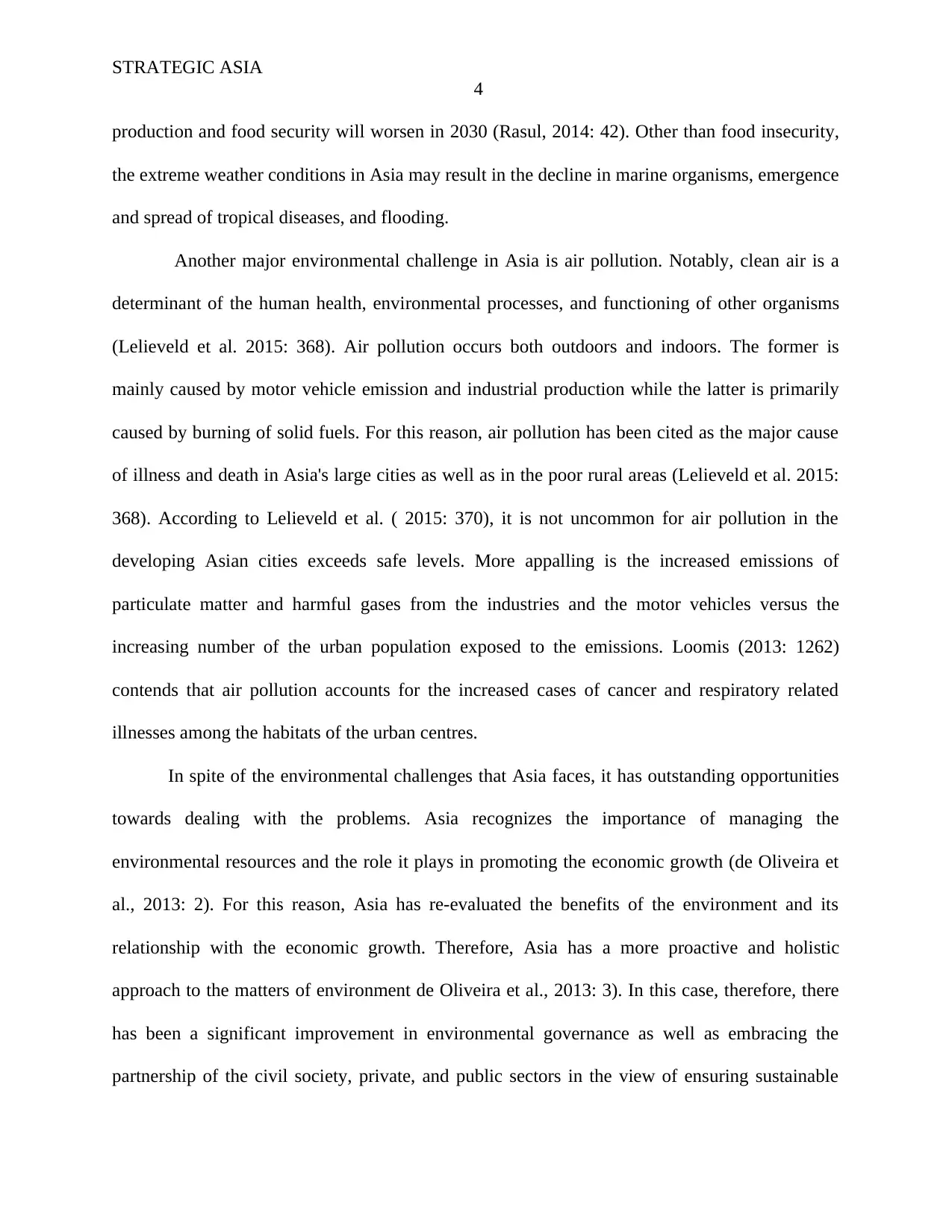
STRATEGIC ASIA
4
production and food security will worsen in 2030 (Rasul, 2014: 42). Other than food insecurity,
the extreme weather conditions in Asia may result in the decline in marine organisms, emergence
and spread of tropical diseases, and flooding.
Another major environmental challenge in Asia is air pollution. Notably, clean air is a
determinant of the human health, environmental processes, and functioning of other organisms
(Lelieveld et al. 2015: 368). Air pollution occurs both outdoors and indoors. The former is
mainly caused by motor vehicle emission and industrial production while the latter is primarily
caused by burning of solid fuels. For this reason, air pollution has been cited as the major cause
of illness and death in Asia's large cities as well as in the poor rural areas (Lelieveld et al. 2015:
368). According to Lelieveld et al. ( 2015: 370), it is not uncommon for air pollution in the
developing Asian cities exceeds safe levels. More appalling is the increased emissions of
particulate matter and harmful gases from the industries and the motor vehicles versus the
increasing number of the urban population exposed to the emissions. Loomis (2013: 1262)
contends that air pollution accounts for the increased cases of cancer and respiratory related
illnesses among the habitats of the urban centres.
In spite of the environmental challenges that Asia faces, it has outstanding opportunities
towards dealing with the problems. Asia recognizes the importance of managing the
environmental resources and the role it plays in promoting the economic growth (de Oliveira et
al., 2013: 2). For this reason, Asia has re-evaluated the benefits of the environment and its
relationship with the economic growth. Therefore, Asia has a more proactive and holistic
approach to the matters of environment de Oliveira et al., 2013: 3). In this case, therefore, there
has been a significant improvement in environmental governance as well as embracing the
partnership of the civil society, private, and public sectors in the view of ensuring sustainable
4
production and food security will worsen in 2030 (Rasul, 2014: 42). Other than food insecurity,
the extreme weather conditions in Asia may result in the decline in marine organisms, emergence
and spread of tropical diseases, and flooding.
Another major environmental challenge in Asia is air pollution. Notably, clean air is a
determinant of the human health, environmental processes, and functioning of other organisms
(Lelieveld et al. 2015: 368). Air pollution occurs both outdoors and indoors. The former is
mainly caused by motor vehicle emission and industrial production while the latter is primarily
caused by burning of solid fuels. For this reason, air pollution has been cited as the major cause
of illness and death in Asia's large cities as well as in the poor rural areas (Lelieveld et al. 2015:
368). According to Lelieveld et al. ( 2015: 370), it is not uncommon for air pollution in the
developing Asian cities exceeds safe levels. More appalling is the increased emissions of
particulate matter and harmful gases from the industries and the motor vehicles versus the
increasing number of the urban population exposed to the emissions. Loomis (2013: 1262)
contends that air pollution accounts for the increased cases of cancer and respiratory related
illnesses among the habitats of the urban centres.
In spite of the environmental challenges that Asia faces, it has outstanding opportunities
towards dealing with the problems. Asia recognizes the importance of managing the
environmental resources and the role it plays in promoting the economic growth (de Oliveira et
al., 2013: 2). For this reason, Asia has re-evaluated the benefits of the environment and its
relationship with the economic growth. Therefore, Asia has a more proactive and holistic
approach to the matters of environment de Oliveira et al., 2013: 3). In this case, therefore, there
has been a significant improvement in environmental governance as well as embracing the
partnership of the civil society, private, and public sectors in the view of ensuring sustainable
Paraphrase This Document
Need a fresh take? Get an instant paraphrase of this document with our AI Paraphraser
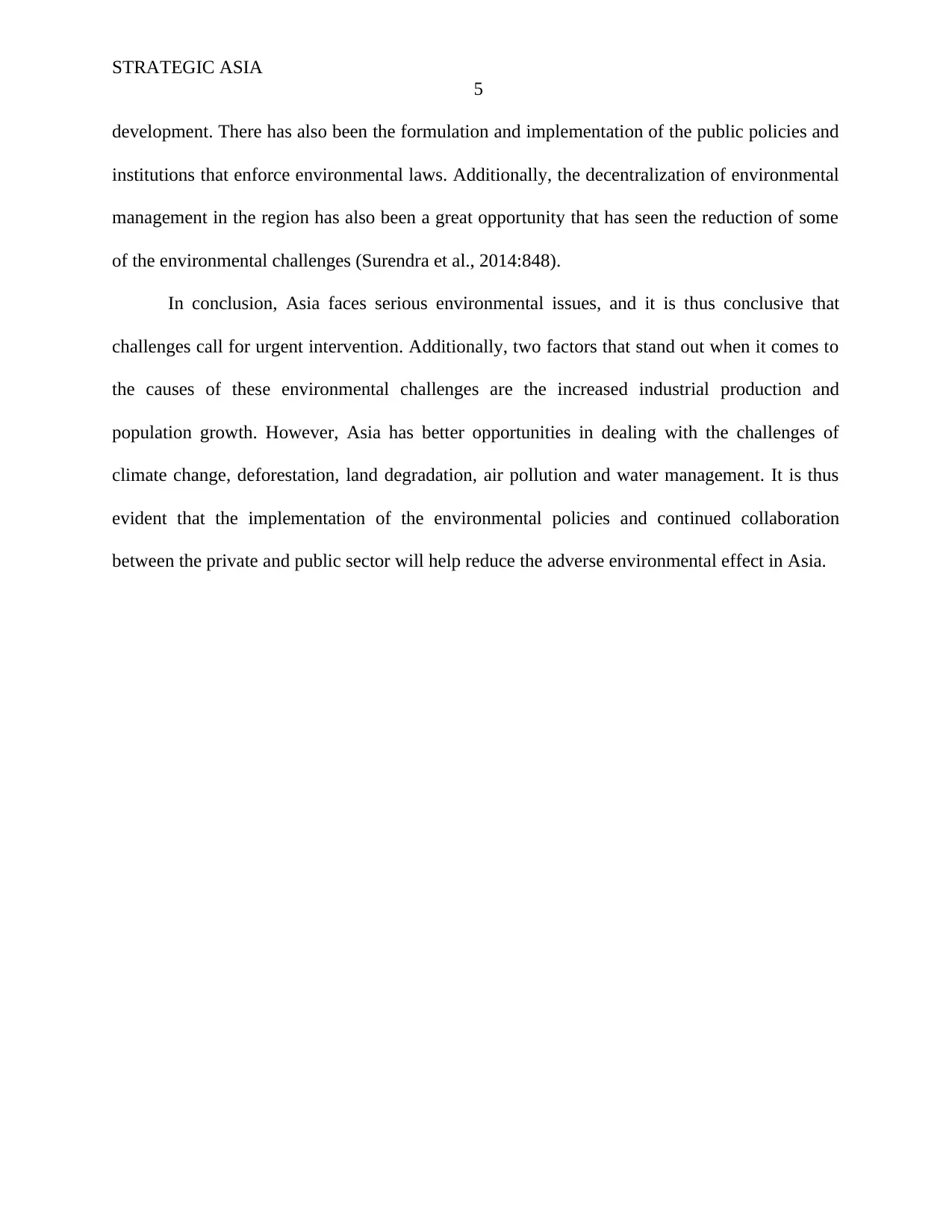
STRATEGIC ASIA
5
development. There has also been the formulation and implementation of the public policies and
institutions that enforce environmental laws. Additionally, the decentralization of environmental
management in the region has also been a great opportunity that has seen the reduction of some
of the environmental challenges (Surendra et al., 2014:848).
In conclusion, Asia faces serious environmental issues, and it is thus conclusive that
challenges call for urgent intervention. Additionally, two factors that stand out when it comes to
the causes of these environmental challenges are the increased industrial production and
population growth. However, Asia has better opportunities in dealing with the challenges of
climate change, deforestation, land degradation, air pollution and water management. It is thus
evident that the implementation of the environmental policies and continued collaboration
between the private and public sector will help reduce the adverse environmental effect in Asia.
5
development. There has also been the formulation and implementation of the public policies and
institutions that enforce environmental laws. Additionally, the decentralization of environmental
management in the region has also been a great opportunity that has seen the reduction of some
of the environmental challenges (Surendra et al., 2014:848).
In conclusion, Asia faces serious environmental issues, and it is thus conclusive that
challenges call for urgent intervention. Additionally, two factors that stand out when it comes to
the causes of these environmental challenges are the increased industrial production and
population growth. However, Asia has better opportunities in dealing with the challenges of
climate change, deforestation, land degradation, air pollution and water management. It is thus
evident that the implementation of the environmental policies and continued collaboration
between the private and public sector will help reduce the adverse environmental effect in Asia.
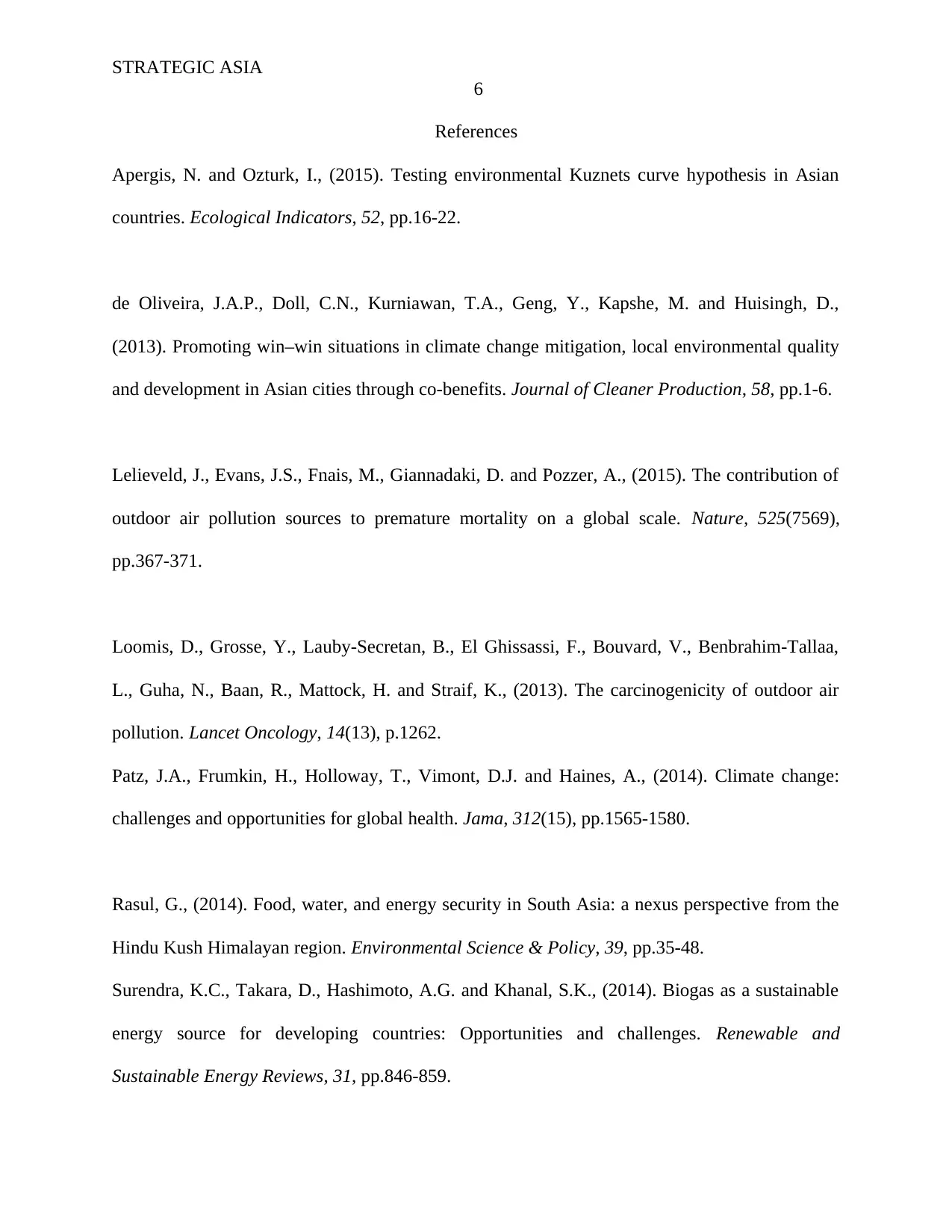
STRATEGIC ASIA
6
References
Apergis, N. and Ozturk, I., (2015). Testing environmental Kuznets curve hypothesis in Asian
countries. Ecological Indicators, 52, pp.16-22.
de Oliveira, J.A.P., Doll, C.N., Kurniawan, T.A., Geng, Y., Kapshe, M. and Huisingh, D.,
(2013). Promoting win–win situations in climate change mitigation, local environmental quality
and development in Asian cities through co-benefits. Journal of Cleaner Production, 58, pp.1-6.
Lelieveld, J., Evans, J.S., Fnais, M., Giannadaki, D. and Pozzer, A., (2015). The contribution of
outdoor air pollution sources to premature mortality on a global scale. Nature, 525(7569),
pp.367-371.
Loomis, D., Grosse, Y., Lauby-Secretan, B., El Ghissassi, F., Bouvard, V., Benbrahim-Tallaa,
L., Guha, N., Baan, R., Mattock, H. and Straif, K., (2013). The carcinogenicity of outdoor air
pollution. Lancet Oncology, 14(13), p.1262.
Patz, J.A., Frumkin, H., Holloway, T., Vimont, D.J. and Haines, A., (2014). Climate change:
challenges and opportunities for global health. Jama, 312(15), pp.1565-1580.
Rasul, G., (2014). Food, water, and energy security in South Asia: a nexus perspective from the
Hindu Kush Himalayan region. Environmental Science & Policy, 39, pp.35-48.
Surendra, K.C., Takara, D., Hashimoto, A.G. and Khanal, S.K., (2014). Biogas as a sustainable
energy source for developing countries: Opportunities and challenges. Renewable and
Sustainable Energy Reviews, 31, pp.846-859.
6
References
Apergis, N. and Ozturk, I., (2015). Testing environmental Kuznets curve hypothesis in Asian
countries. Ecological Indicators, 52, pp.16-22.
de Oliveira, J.A.P., Doll, C.N., Kurniawan, T.A., Geng, Y., Kapshe, M. and Huisingh, D.,
(2013). Promoting win–win situations in climate change mitigation, local environmental quality
and development in Asian cities through co-benefits. Journal of Cleaner Production, 58, pp.1-6.
Lelieveld, J., Evans, J.S., Fnais, M., Giannadaki, D. and Pozzer, A., (2015). The contribution of
outdoor air pollution sources to premature mortality on a global scale. Nature, 525(7569),
pp.367-371.
Loomis, D., Grosse, Y., Lauby-Secretan, B., El Ghissassi, F., Bouvard, V., Benbrahim-Tallaa,
L., Guha, N., Baan, R., Mattock, H. and Straif, K., (2013). The carcinogenicity of outdoor air
pollution. Lancet Oncology, 14(13), p.1262.
Patz, J.A., Frumkin, H., Holloway, T., Vimont, D.J. and Haines, A., (2014). Climate change:
challenges and opportunities for global health. Jama, 312(15), pp.1565-1580.
Rasul, G., (2014). Food, water, and energy security in South Asia: a nexus perspective from the
Hindu Kush Himalayan region. Environmental Science & Policy, 39, pp.35-48.
Surendra, K.C., Takara, D., Hashimoto, A.G. and Khanal, S.K., (2014). Biogas as a sustainable
energy source for developing countries: Opportunities and challenges. Renewable and
Sustainable Energy Reviews, 31, pp.846-859.
⊘ This is a preview!⊘
Do you want full access?
Subscribe today to unlock all pages.

Trusted by 1+ million students worldwide
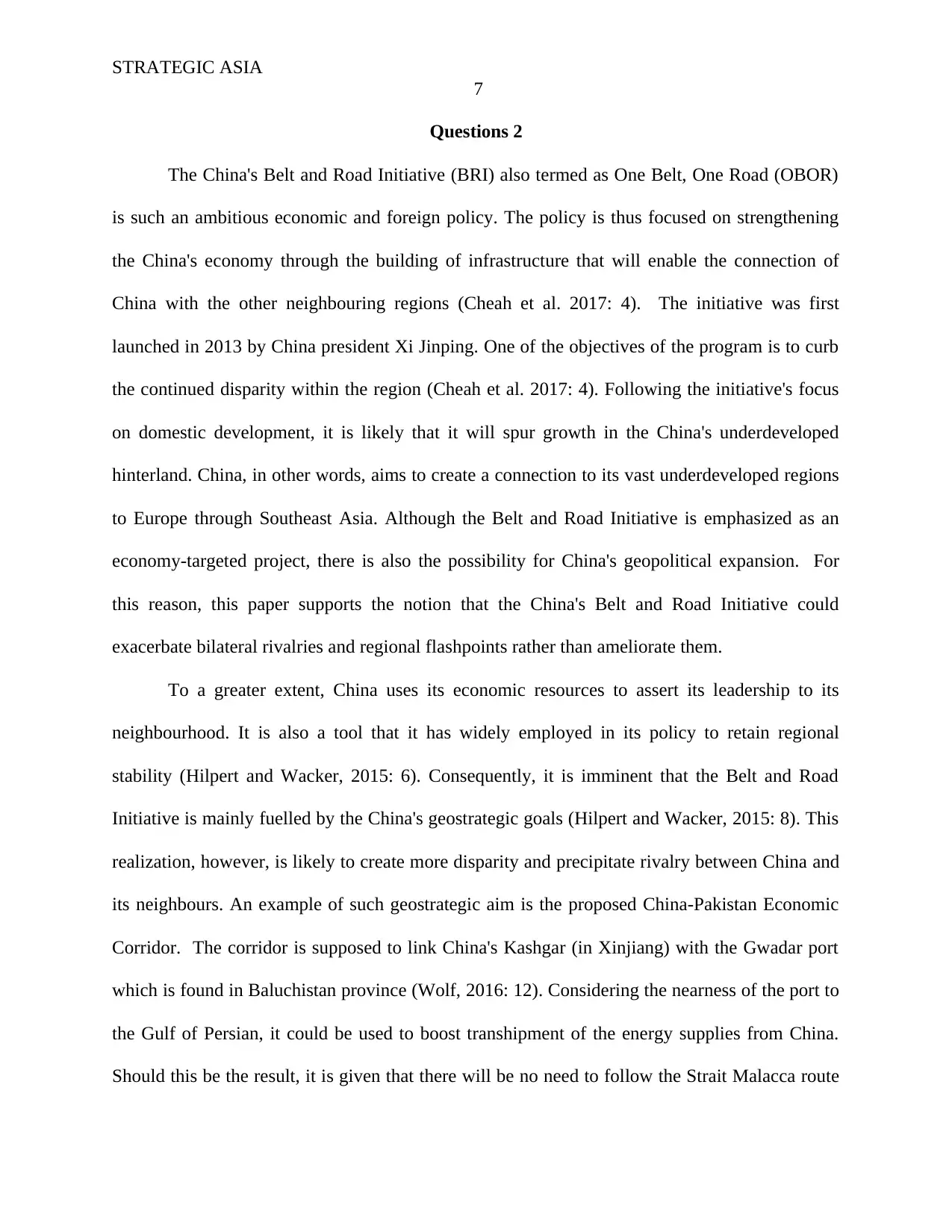
STRATEGIC ASIA
7
Questions 2
The China's Belt and Road Initiative (BRI) also termed as One Belt, One Road (OBOR)
is such an ambitious economic and foreign policy. The policy is thus focused on strengthening
the China's economy through the building of infrastructure that will enable the connection of
China with the other neighbouring regions (Cheah et al. 2017: 4). The initiative was first
launched in 2013 by China president Xi Jinping. One of the objectives of the program is to curb
the continued disparity within the region (Cheah et al. 2017: 4). Following the initiative's focus
on domestic development, it is likely that it will spur growth in the China's underdeveloped
hinterland. China, in other words, aims to create a connection to its vast underdeveloped regions
to Europe through Southeast Asia. Although the Belt and Road Initiative is emphasized as an
economy-targeted project, there is also the possibility for China's geopolitical expansion. For
this reason, this paper supports the notion that the China's Belt and Road Initiative could
exacerbate bilateral rivalries and regional flashpoints rather than ameliorate them.
To a greater extent, China uses its economic resources to assert its leadership to its
neighbourhood. It is also a tool that it has widely employed in its policy to retain regional
stability (Hilpert and Wacker, 2015: 6). Consequently, it is imminent that the Belt and Road
Initiative is mainly fuelled by the China's geostrategic goals (Hilpert and Wacker, 2015: 8). This
realization, however, is likely to create more disparity and precipitate rivalry between China and
its neighbours. An example of such geostrategic aim is the proposed China-Pakistan Economic
Corridor. The corridor is supposed to link China's Kashgar (in Xinjiang) with the Gwadar port
which is found in Baluchistan province (Wolf, 2016: 12). Considering the nearness of the port to
the Gulf of Persian, it could be used to boost transhipment of the energy supplies from China.
Should this be the result, it is given that there will be no need to follow the Strait Malacca route
7
Questions 2
The China's Belt and Road Initiative (BRI) also termed as One Belt, One Road (OBOR)
is such an ambitious economic and foreign policy. The policy is thus focused on strengthening
the China's economy through the building of infrastructure that will enable the connection of
China with the other neighbouring regions (Cheah et al. 2017: 4). The initiative was first
launched in 2013 by China president Xi Jinping. One of the objectives of the program is to curb
the continued disparity within the region (Cheah et al. 2017: 4). Following the initiative's focus
on domestic development, it is likely that it will spur growth in the China's underdeveloped
hinterland. China, in other words, aims to create a connection to its vast underdeveloped regions
to Europe through Southeast Asia. Although the Belt and Road Initiative is emphasized as an
economy-targeted project, there is also the possibility for China's geopolitical expansion. For
this reason, this paper supports the notion that the China's Belt and Road Initiative could
exacerbate bilateral rivalries and regional flashpoints rather than ameliorate them.
To a greater extent, China uses its economic resources to assert its leadership to its
neighbourhood. It is also a tool that it has widely employed in its policy to retain regional
stability (Hilpert and Wacker, 2015: 6). Consequently, it is imminent that the Belt and Road
Initiative is mainly fuelled by the China's geostrategic goals (Hilpert and Wacker, 2015: 8). This
realization, however, is likely to create more disparity and precipitate rivalry between China and
its neighbours. An example of such geostrategic aim is the proposed China-Pakistan Economic
Corridor. The corridor is supposed to link China's Kashgar (in Xinjiang) with the Gwadar port
which is found in Baluchistan province (Wolf, 2016: 12). Considering the nearness of the port to
the Gulf of Persian, it could be used to boost transhipment of the energy supplies from China.
Should this be the result, it is given that there will be no need to follow the Strait Malacca route
Paraphrase This Document
Need a fresh take? Get an instant paraphrase of this document with our AI Paraphraser
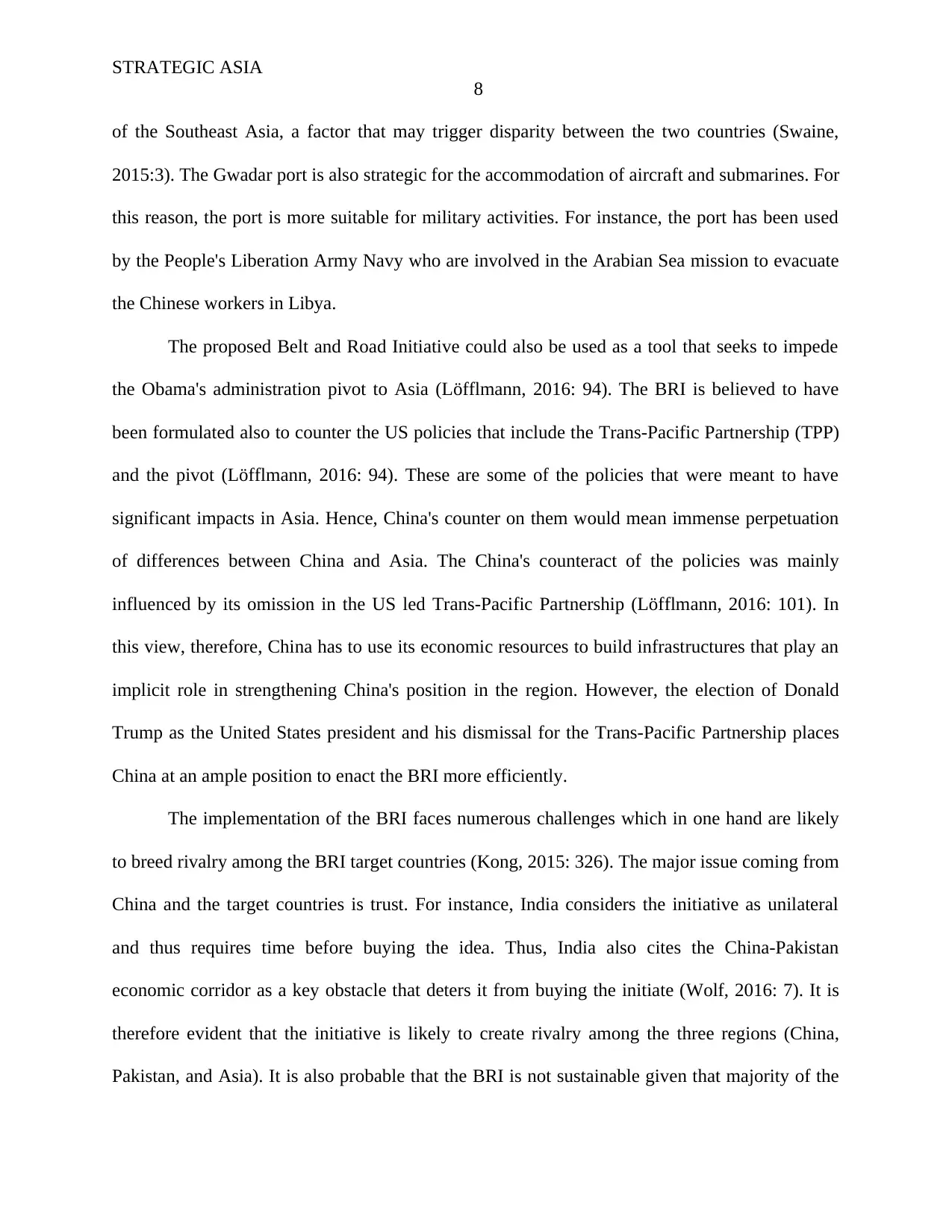
STRATEGIC ASIA
8
of the Southeast Asia, a factor that may trigger disparity between the two countries (Swaine,
2015:3). The Gwadar port is also strategic for the accommodation of aircraft and submarines. For
this reason, the port is more suitable for military activities. For instance, the port has been used
by the People's Liberation Army Navy who are involved in the Arabian Sea mission to evacuate
the Chinese workers in Libya.
The proposed Belt and Road Initiative could also be used as a tool that seeks to impede
the Obama's administration pivot to Asia (Löfflmann, 2016: 94). The BRI is believed to have
been formulated also to counter the US policies that include the Trans-Pacific Partnership (TPP)
and the pivot (Löfflmann, 2016: 94). These are some of the policies that were meant to have
significant impacts in Asia. Hence, China's counter on them would mean immense perpetuation
of differences between China and Asia. The China's counteract of the policies was mainly
influenced by its omission in the US led Trans-Pacific Partnership (Löfflmann, 2016: 101). In
this view, therefore, China has to use its economic resources to build infrastructures that play an
implicit role in strengthening China's position in the region. However, the election of Donald
Trump as the United States president and his dismissal for the Trans-Pacific Partnership places
China at an ample position to enact the BRI more efficiently.
The implementation of the BRI faces numerous challenges which in one hand are likely
to breed rivalry among the BRI target countries (Kong, 2015: 326). The major issue coming from
China and the target countries is trust. For instance, India considers the initiative as unilateral
and thus requires time before buying the idea. Thus, India also cites the China-Pakistan
economic corridor as a key obstacle that deters it from buying the initiate (Wolf, 2016: 7). It is
therefore evident that the initiative is likely to create rivalry among the three regions (China,
Pakistan, and Asia). It is also probable that the BRI is not sustainable given that majority of the
8
of the Southeast Asia, a factor that may trigger disparity between the two countries (Swaine,
2015:3). The Gwadar port is also strategic for the accommodation of aircraft and submarines. For
this reason, the port is more suitable for military activities. For instance, the port has been used
by the People's Liberation Army Navy who are involved in the Arabian Sea mission to evacuate
the Chinese workers in Libya.
The proposed Belt and Road Initiative could also be used as a tool that seeks to impede
the Obama's administration pivot to Asia (Löfflmann, 2016: 94). The BRI is believed to have
been formulated also to counter the US policies that include the Trans-Pacific Partnership (TPP)
and the pivot (Löfflmann, 2016: 94). These are some of the policies that were meant to have
significant impacts in Asia. Hence, China's counter on them would mean immense perpetuation
of differences between China and Asia. The China's counteract of the policies was mainly
influenced by its omission in the US led Trans-Pacific Partnership (Löfflmann, 2016: 101). In
this view, therefore, China has to use its economic resources to build infrastructures that play an
implicit role in strengthening China's position in the region. However, the election of Donald
Trump as the United States president and his dismissal for the Trans-Pacific Partnership places
China at an ample position to enact the BRI more efficiently.
The implementation of the BRI faces numerous challenges which in one hand are likely
to breed rivalry among the BRI target countries (Kong, 2015: 326). The major issue coming from
China and the target countries is trust. For instance, India considers the initiative as unilateral
and thus requires time before buying the idea. Thus, India also cites the China-Pakistan
economic corridor as a key obstacle that deters it from buying the initiate (Wolf, 2016: 7). It is
therefore evident that the initiative is likely to create rivalry among the three regions (China,
Pakistan, and Asia). It is also probable that the BRI is not sustainable given that majority of the
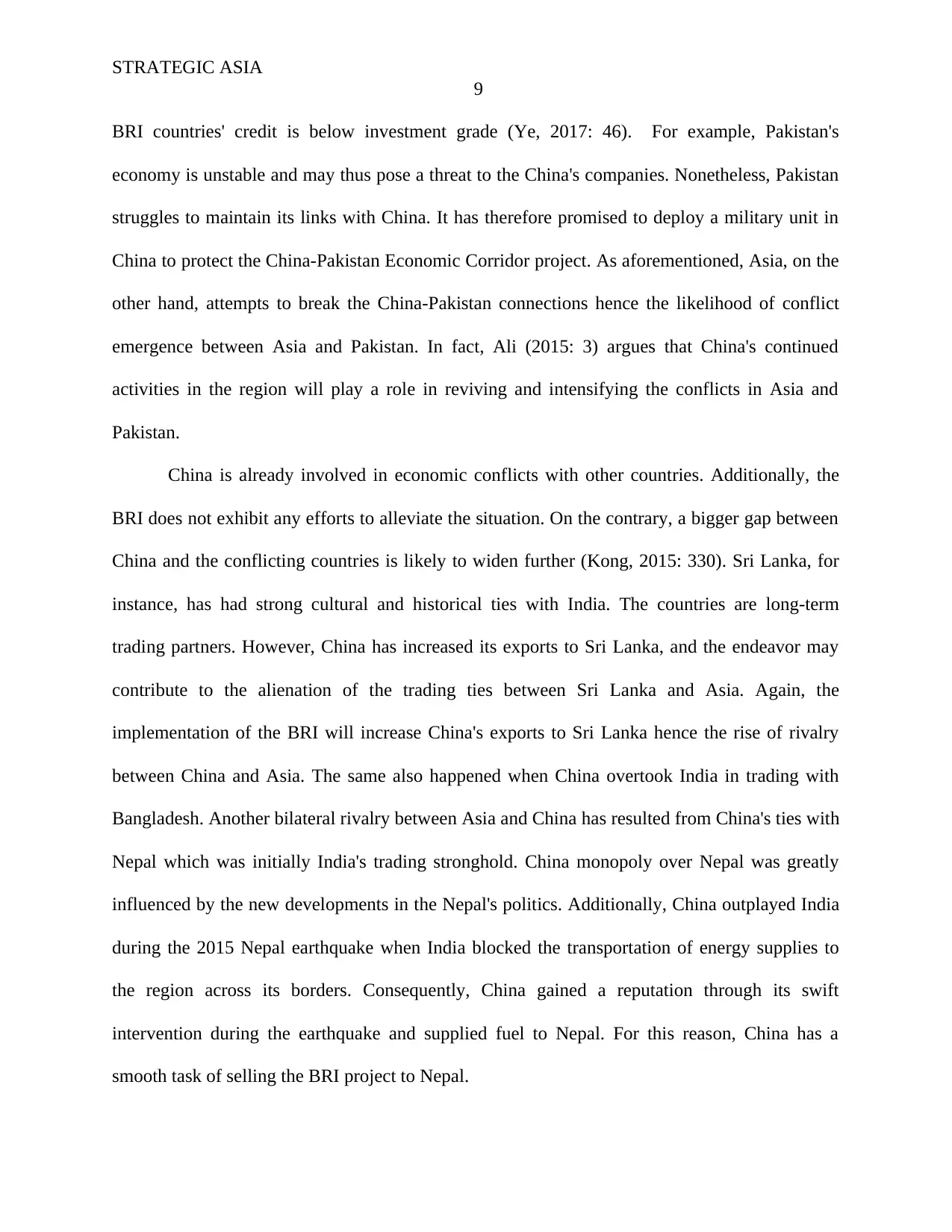
STRATEGIC ASIA
9
BRI countries' credit is below investment grade (Ye, 2017: 46). For example, Pakistan's
economy is unstable and may thus pose a threat to the China's companies. Nonetheless, Pakistan
struggles to maintain its links with China. It has therefore promised to deploy a military unit in
China to protect the China-Pakistan Economic Corridor project. As aforementioned, Asia, on the
other hand, attempts to break the China-Pakistan connections hence the likelihood of conflict
emergence between Asia and Pakistan. In fact, Ali (2015: 3) argues that China's continued
activities in the region will play a role in reviving and intensifying the conflicts in Asia and
Pakistan.
China is already involved in economic conflicts with other countries. Additionally, the
BRI does not exhibit any efforts to alleviate the situation. On the contrary, a bigger gap between
China and the conflicting countries is likely to widen further (Kong, 2015: 330). Sri Lanka, for
instance, has had strong cultural and historical ties with India. The countries are long-term
trading partners. However, China has increased its exports to Sri Lanka, and the endeavor may
contribute to the alienation of the trading ties between Sri Lanka and Asia. Again, the
implementation of the BRI will increase China's exports to Sri Lanka hence the rise of rivalry
between China and Asia. The same also happened when China overtook India in trading with
Bangladesh. Another bilateral rivalry between Asia and China has resulted from China's ties with
Nepal which was initially India's trading stronghold. China monopoly over Nepal was greatly
influenced by the new developments in the Nepal's politics. Additionally, China outplayed India
during the 2015 Nepal earthquake when India blocked the transportation of energy supplies to
the region across its borders. Consequently, China gained a reputation through its swift
intervention during the earthquake and supplied fuel to Nepal. For this reason, China has a
smooth task of selling the BRI project to Nepal.
9
BRI countries' credit is below investment grade (Ye, 2017: 46). For example, Pakistan's
economy is unstable and may thus pose a threat to the China's companies. Nonetheless, Pakistan
struggles to maintain its links with China. It has therefore promised to deploy a military unit in
China to protect the China-Pakistan Economic Corridor project. As aforementioned, Asia, on the
other hand, attempts to break the China-Pakistan connections hence the likelihood of conflict
emergence between Asia and Pakistan. In fact, Ali (2015: 3) argues that China's continued
activities in the region will play a role in reviving and intensifying the conflicts in Asia and
Pakistan.
China is already involved in economic conflicts with other countries. Additionally, the
BRI does not exhibit any efforts to alleviate the situation. On the contrary, a bigger gap between
China and the conflicting countries is likely to widen further (Kong, 2015: 330). Sri Lanka, for
instance, has had strong cultural and historical ties with India. The countries are long-term
trading partners. However, China has increased its exports to Sri Lanka, and the endeavor may
contribute to the alienation of the trading ties between Sri Lanka and Asia. Again, the
implementation of the BRI will increase China's exports to Sri Lanka hence the rise of rivalry
between China and Asia. The same also happened when China overtook India in trading with
Bangladesh. Another bilateral rivalry between Asia and China has resulted from China's ties with
Nepal which was initially India's trading stronghold. China monopoly over Nepal was greatly
influenced by the new developments in the Nepal's politics. Additionally, China outplayed India
during the 2015 Nepal earthquake when India blocked the transportation of energy supplies to
the region across its borders. Consequently, China gained a reputation through its swift
intervention during the earthquake and supplied fuel to Nepal. For this reason, China has a
smooth task of selling the BRI project to Nepal.
⊘ This is a preview!⊘
Do you want full access?
Subscribe today to unlock all pages.

Trusted by 1+ million students worldwide
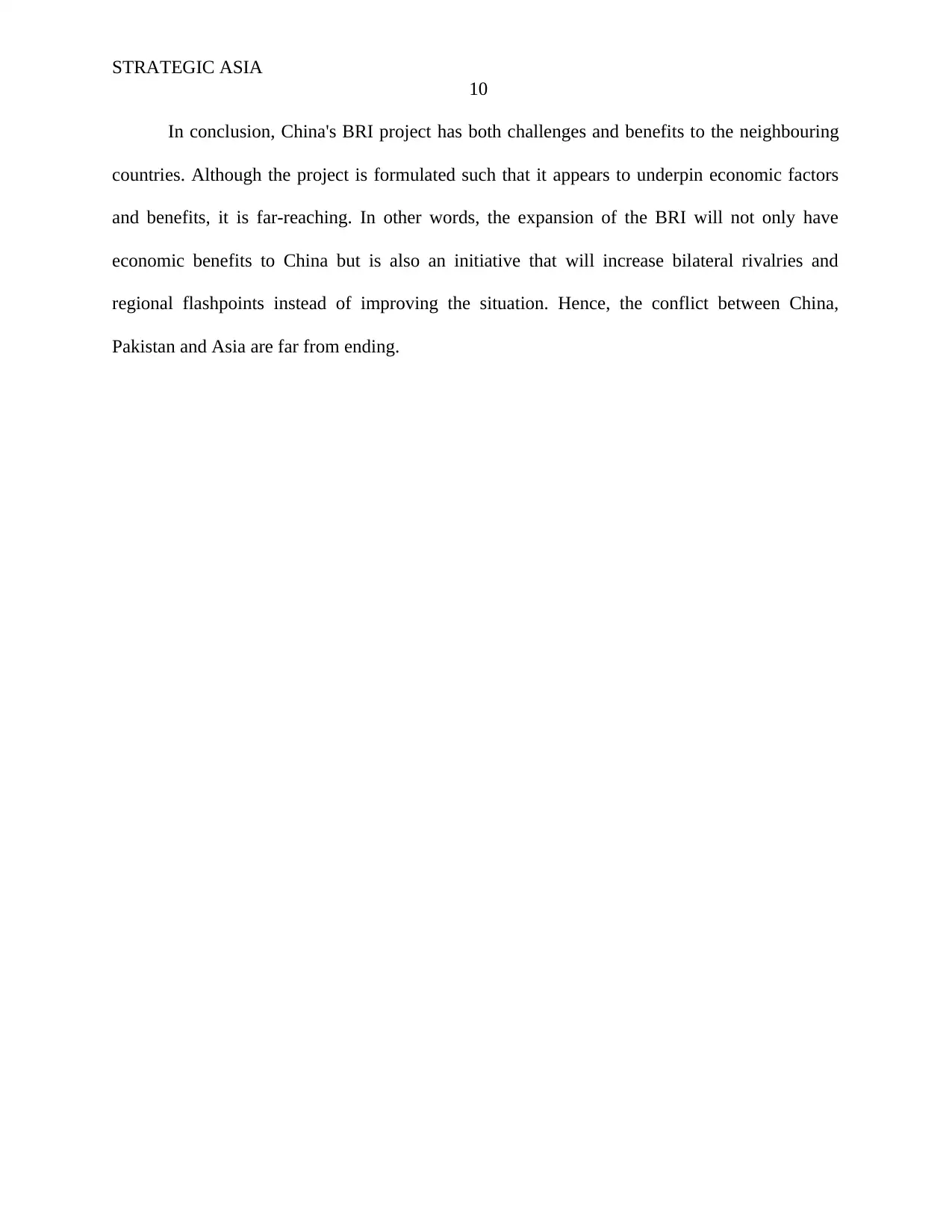
STRATEGIC ASIA
10
In conclusion, China's BRI project has both challenges and benefits to the neighbouring
countries. Although the project is formulated such that it appears to underpin economic factors
and benefits, it is far-reaching. In other words, the expansion of the BRI will not only have
economic benefits to China but is also an initiative that will increase bilateral rivalries and
regional flashpoints instead of improving the situation. Hence, the conflict between China,
Pakistan and Asia are far from ending.
10
In conclusion, China's BRI project has both challenges and benefits to the neighbouring
countries. Although the project is formulated such that it appears to underpin economic factors
and benefits, it is far-reaching. In other words, the expansion of the BRI will not only have
economic benefits to China but is also an initiative that will increase bilateral rivalries and
regional flashpoints instead of improving the situation. Hence, the conflict between China,
Pakistan and Asia are far from ending.
Paraphrase This Document
Need a fresh take? Get an instant paraphrase of this document with our AI Paraphraser
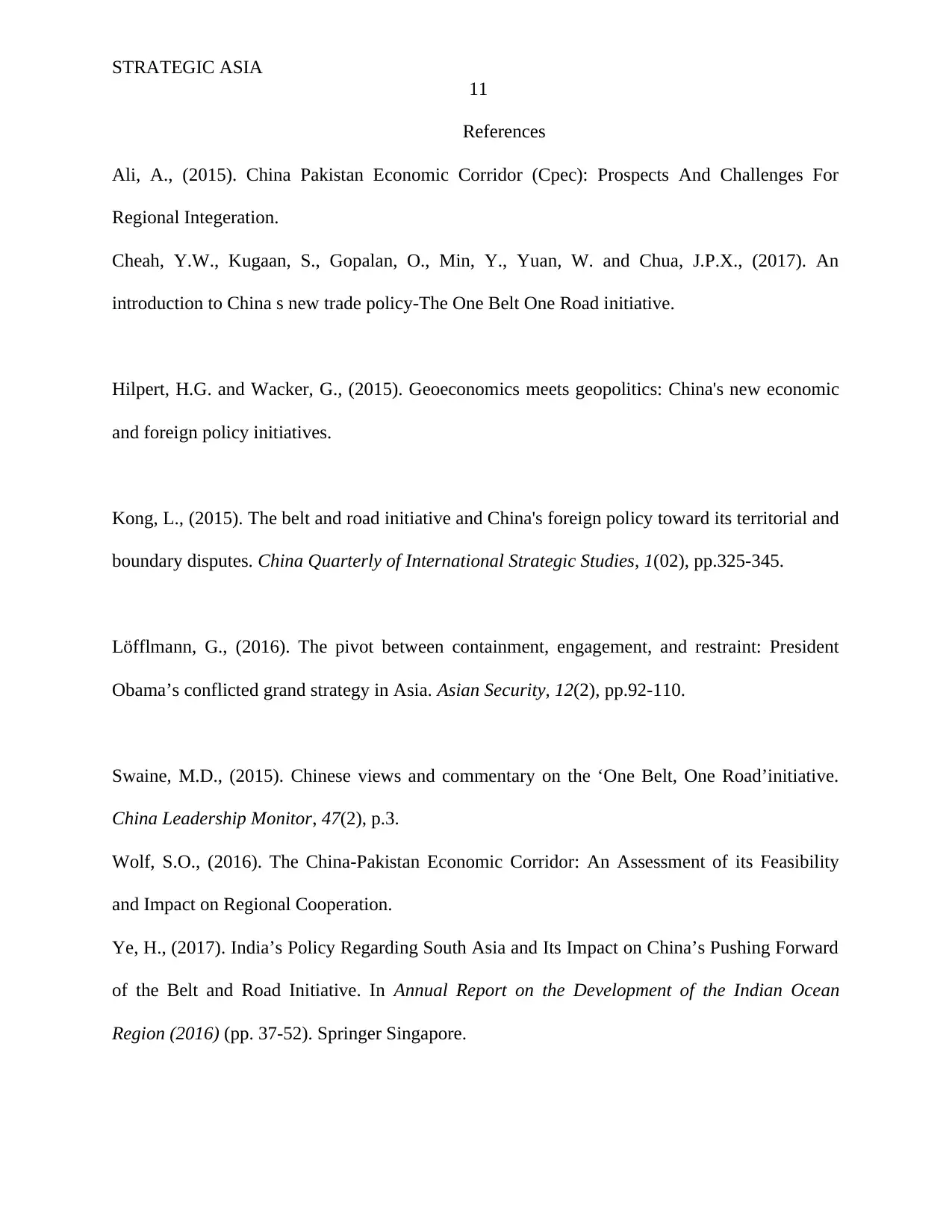
STRATEGIC ASIA
11
References
Ali, A., (2015). China Pakistan Economic Corridor (Cpec): Prospects And Challenges For
Regional Integeration.
Cheah, Y.W., Kugaan, S., Gopalan, O., Min, Y., Yuan, W. and Chua, J.P.X., (2017). An
introduction to China s new trade policy-The One Belt One Road initiative.
Hilpert, H.G. and Wacker, G., (2015). Geoeconomics meets geopolitics: China's new economic
and foreign policy initiatives.
Kong, L., (2015). The belt and road initiative and China's foreign policy toward its territorial and
boundary disputes. China Quarterly of International Strategic Studies, 1(02), pp.325-345.
Löfflmann, G., (2016). The pivot between containment, engagement, and restraint: President
Obama’s conflicted grand strategy in Asia. Asian Security, 12(2), pp.92-110.
Swaine, M.D., (2015). Chinese views and commentary on the ‘One Belt, One Road’initiative.
China Leadership Monitor, 47(2), p.3.
Wolf, S.O., (2016). The China-Pakistan Economic Corridor: An Assessment of its Feasibility
and Impact on Regional Cooperation.
Ye, H., (2017). India’s Policy Regarding South Asia and Its Impact on China’s Pushing Forward
of the Belt and Road Initiative. In Annual Report on the Development of the Indian Ocean
Region (2016) (pp. 37-52). Springer Singapore.
11
References
Ali, A., (2015). China Pakistan Economic Corridor (Cpec): Prospects And Challenges For
Regional Integeration.
Cheah, Y.W., Kugaan, S., Gopalan, O., Min, Y., Yuan, W. and Chua, J.P.X., (2017). An
introduction to China s new trade policy-The One Belt One Road initiative.
Hilpert, H.G. and Wacker, G., (2015). Geoeconomics meets geopolitics: China's new economic
and foreign policy initiatives.
Kong, L., (2015). The belt and road initiative and China's foreign policy toward its territorial and
boundary disputes. China Quarterly of International Strategic Studies, 1(02), pp.325-345.
Löfflmann, G., (2016). The pivot between containment, engagement, and restraint: President
Obama’s conflicted grand strategy in Asia. Asian Security, 12(2), pp.92-110.
Swaine, M.D., (2015). Chinese views and commentary on the ‘One Belt, One Road’initiative.
China Leadership Monitor, 47(2), p.3.
Wolf, S.O., (2016). The China-Pakistan Economic Corridor: An Assessment of its Feasibility
and Impact on Regional Cooperation.
Ye, H., (2017). India’s Policy Regarding South Asia and Its Impact on China’s Pushing Forward
of the Belt and Road Initiative. In Annual Report on the Development of the Indian Ocean
Region (2016) (pp. 37-52). Springer Singapore.
1 out of 11
Related Documents
Your All-in-One AI-Powered Toolkit for Academic Success.
+13062052269
info@desklib.com
Available 24*7 on WhatsApp / Email
![[object Object]](/_next/static/media/star-bottom.7253800d.svg)
Unlock your academic potential
Copyright © 2020–2025 A2Z Services. All Rights Reserved. Developed and managed by ZUCOL.





